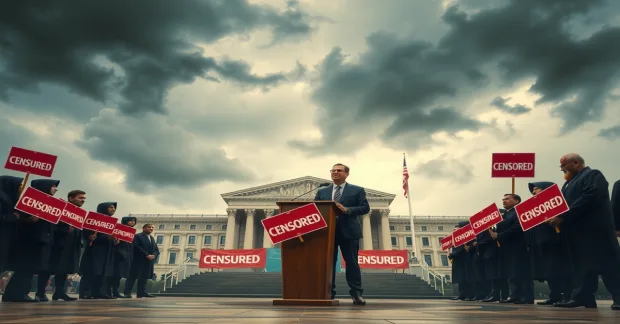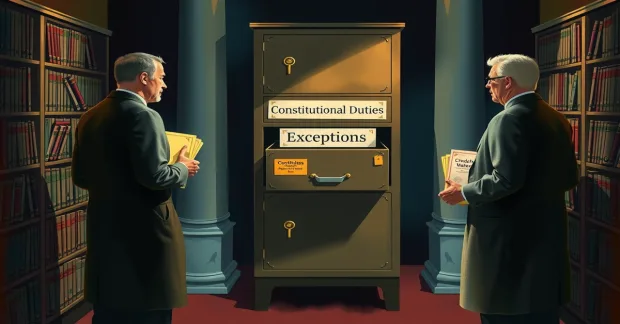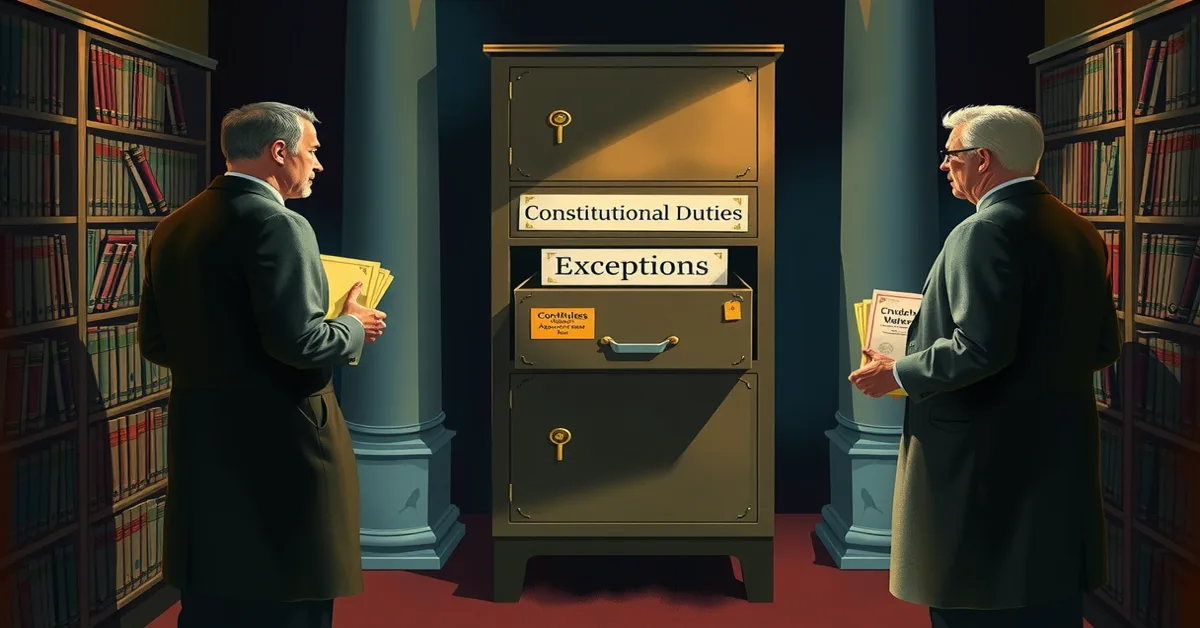
Congress has quietly shifted lawmaking to unelected bodies, and he, she, and they must ask: who governs when faceless agencies write binding rules? This informative overview explains how the delegation loophole lets lawmakers dodge the Constitution while preserving political cover, and it outlines how advocates can push to reclaim legislative power and constitutional accountability.
Key Takeaways:
- Who’s really writing the rules that shape your rights? — Congress increasingly delegates lawmaking to agencies, letting unelected officials issue binding regulations that affect daily life.
- Is delegation sharing power or abandoning it? — The Constitution vests legislative power in Congress; widespread delegation has turned policy-making into agency-driven rulemaking.
- How did the courts enable this transfer? — The “intelligible principle” doctrine lets statutes authorize broad agency action with minimal guidance, creating a legal escape hatch for lawmakers.
- Feel the accountability gap? — Delegation lets members of Congress avoid responsibility while unaccountable bureaucrats make consequential decisions.
- When does efficiency become a constitutional surrender? — Routine delegation concentrates executive authority and blurs the separation of powers the Framers intended.
- Can the courts restore the balance? — Recent cases and the major questions doctrine suggest the judiciary may finally draw limits on excessive delegations and push Congress to legislate directly.
- What’s at stake for everyday Americans? — Unchecked agency rulemaking shapes business rules, privacy, emergency responses, and even war powers, making congressional responsibility a practical safeguard for liberties.
The Constitutional Foundation: Understanding Legislative Powers
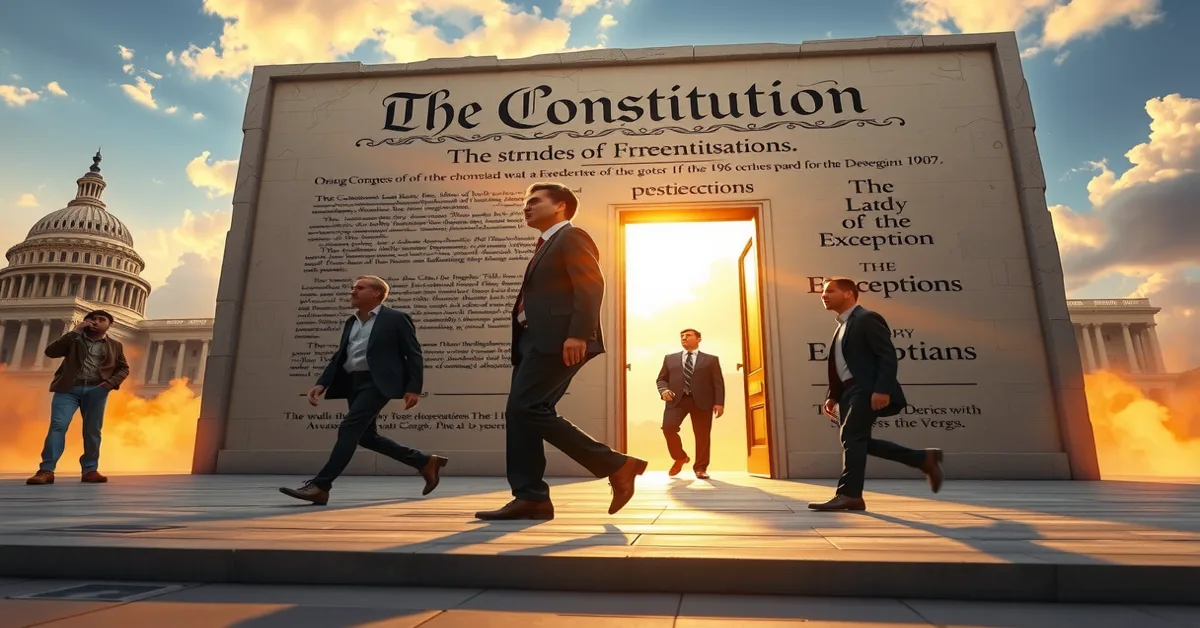
Article I is the constitutional anchor for lawmaking: “All legislative powers herein granted shall be vested in a Congress of the United States.” He, she, and they who framed the text assigned Congress the primary duty to write laws, enumerate powers, and check the executive; when Congress hands that authority away, the balance shifts. Which powers did they list, and how was the transfer supposed to be limited?
Overview of Article I: Structure and Purpose — what did it assign?
Article I, Section 1 vests lawmaking in Congress and Section 8 lists the 18 enumerated powers — from taxation to regulating commerce and declaring war — with the Necessary and Proper Clause as Clause 18. They expected specificity; courts and statutes since the 1930s transformed broad language into sweeping agency authority (see Wickard v. Filburn, 1942), creating the modern gap between statutory text and administrative rulemaking.
The Intent of the Founding Fathers
The Founders, including Madison and Hamilton, designed Congress as the people’s lawgiver and built separation of powers to prevent concentration; he wrote in Federalist No. 51 that ambition must check ambition. They feared vague delegations, so when statutes leave lawmaking to others, the original design for accountability and restraint is endangered.
At Philadelphia in 1787 — where roughly 55 delegates debated structure — notes from Madison and Anti‑Federalist objections show they intended the Necessary and Proper Clause to support execution of enumerated duties, not to create open-ended rulemaking. She and they expected legislators to bear the political cost of choices; delegations that let agencies set binding standards amount to a de facto transfer of the people’s lawmaking power.
The Role of Legislative Authority in a Republic
Congress’s powers — taxing, spending, declaring war, and oversight — are functional checks: the power of the purse, impeachment, and confirmation leverage legislative control. He, she, and they in office are meant to translate public will into law and then supervise execution; when authority migrates to rulemakers, those checks weaken and accountability frays.
Historically Congress has tried to reclaim authority using appropriations, hearings, and statutes like the 1973 War Powers Resolution; yet modern statutory schemes (for example, broad delegations underpinning regulatory regimes) often blunt these tools. They who control spending and process retain the means to restore balance, but only if Congress stops outsourcing substantive policy choices to unelected officials.
The Framework of Delegation: Congress’s Authority to Delegate
Who decides when lawmaking becomes administrative work? Congress routinely grants agencies authority through statutes that set goals but leave details to others; since the Progressive Era and especially after 1930s reforms, hundreds of statutes have done this. He, she, or they in office can authorize rulemaking, adjudication, and enforcement powers that produce biding regulations, fines, and compliance mandates, effectively shifting lawmaking from Article I to agency rulebooks without a new statute for each technical choice.
Historical Context of Delegation
Why did delegation expand so rapidly? The trend began with the 1887 creation of the Interstate Commerce Commission and accelerated during the New Deal, when Congress faced economic crisis and created agencies to manage complex markets. He, she, or they in Congress found delegation efficient; courts initially struck down some overbroad grants in 1935 (Panama Refining, Schechter), but after that the bench generally allowed broad statutory grants, and administrative governance became the norm across regulatory areas.
Defining Delegation in the Modern Era
How is delegation structured today? Modern delegation typically uses broad statutory standards plus the Administrative Procedure Act (1946) framework, empowering agencies to engage in notice-and-comment rulemaking and publish binding rules in the Code of Federal Regulations. He, she, or they who administer agencies translate vague congressional goals into technical rules, often filling in thousands of pages of regulatory detail that govern industry practices, safety standards, and civil penalties.
More detail shows agencies now decide on specifics under major statutes: for example, the EPA implements the Clean Air Act, the FDA interprets the Food, Drug, and Cosmetic Act, and the SEC enforces securities laws. He, she, or they overseeing agencies issue dozens of significant rules annually, and those rules carry enforcement power, monetary penalties, and compliance obligations that once would have required explicit legislative text.
Legal Precedents Shaping Delegation Practices
Which court decisions set the boundaries? J.W. Hampton (1928) endorsed delegation via an “intelligible principle,” while 1935 cases briefly limited grants. Since then, the Supreme Court has mostly sustained statutory delegations, with Whitman v. American Trucking (2001) reaffirming the permissive standard. He, she, or they on the bench have also carved exceptions—the major questions doctrine and fractured rulings like Gundy (2019) signal the Court’s ongoing struggle over how far Congress may push its authority into agency hands.
Examining recent jurisprudence reveals tension: Whitman rejected a nondelegation challenge to the Clean Air Act, while FDA v. Brown & Williamson (2000) and Gundy prompted the Court to limit agency reach on weighty questions. He, she, or they who study these cases see a pattern where the Court sometimes demands clearer congressional direction for issues of vast economic or political significance, hinting that the era of unchecked delegation may face judicial pushback.
The Consequences of Delegation: Erosion of Legislative Authority
When Congress hands broad power to unelected agencies, they transfer lawmaking away from Article I and create a system where he, she, or they must chase answers from regulators instead of legislators; the result is an erosion of legislative authority that concentrates rulemaking in administrative hands, blurs constitutional boundaries, and lets Congress claim innocence while agencies issue binding rules that reshape markets, privacy, and public health.
How Delegation Undermines Legislative Intent
Statutes with vague standards or an “intelligible principle” enable agencies to interpret congressional goals into technical regimes that often exceed original intent; for example, environmental statutes passed decades ago have been used to justify modern EPA actions far beyond the text, and he, she, or they watching policy shifts see Congress cede core policy choices to experts rather than write precise law.
Accountability Issues Faced by Congress
By outsourcing hard decisions, Congress gains political cover—members can say they did not “write” a regulation while agencies enforce it, and they avoid electoral consequences; meanwhile oversight tools struggle to police thousands of rules appearing in the Federal Register each year, forcing he, she, and they to confront a system where blame is diffuse and responsibility is obscured.
Oversight often fails because Congress lacks the bandwidth: with roughly two million civilian federal employees and agencies issuing tens of thousands of regulatory pages annually, he, she, or they on the Hill face resource and information gaps; hearings and subpoenas are episodic, appropriations riders are blunt instruments, and the incentive to delegate—avoidance of political heat—remains structurally powerful.
The Impact on Citizen Engagement and Representation

When agencies make detailed rules, ordinary citizens confront technical dockets and lengthy rulemakings instead of clear statutes, so he, she, or they find it harder to hold elected representatives accountable; public participation mechanisms exist, yet the complexity of rulemaking turns engagement into a specialist activity and weakens the link between popular will and policy outcomes.
Moreover, many agency leaders serve staggered, multi‑year terms—SEC commissioners, for instance, hold five-year terms—so policy outlasts electoral cycles and dilutes voters’ corrective power; he, she, or they may vote to change a Congress, but the regulatory apparatus can continue implementing delegated authority unchanged, deepening the gap between representation and governance.
The Delegatory Process: Mechanics of Power Transfer
Congress transfers authority through statutes that contain broad grants, emergency clauses, and permissive language—phrases like “as necessary,” “standards,” or “as the Secretary shall prescribe.” They routinely rely on the Administrative Procedure Act (5 U.S.C. § 553) and leave gaps for agencies to fill, producing a system where unelected regulators write binding rules. Examples include environmental, financial, and public-health regimes where Congress set general goals and agencies, not lawmakers, defined the specifics.
How Congress Delegates Power to the Executive Branch
Congress delegates by enacting enabling statutes that authorize executive officials to set standards, create penalties, and implement programs; they embed discretion in phrases such as “to the extent practicable” or “as the Administrator determines.” They use appropriations riders, emergency delegations, and conditional grants to shift decisionmaking, and they often avoid numeric limits, which lets agencies interpret scope and enforceability—producing legally binding rules without detailed legislation.
The Role of Regulatory Agencies in the Delegation Process
Agencies translate statutory gaps into rules via notice-and-comment rulemaking (5 U.S.C. § 553), interpret ambiguous text in adjudications, and enforce violations with fines and orders; courts historically gave them deference under Chevron, magnifying their power. Agencies like the EPA, FDA, and SEC routinely set standards that affect markets and private conduct, turning congressional outlines into operational law.
Agencies rely on a toolkit: proposed rules, final rules, guidance documents, and negotiated settlements. They often deploy cost–benefit analyses (guided by OMB Circular A‑4), technical modeling, and notice periods—commonly 30–60 days—to justify standards; major rules can span hundreds of pages and affect millions of Americans. When they act, they can impose civil penalties, bar market access, or require compliance plans, so their technical determinations become de facto law absent clear congressional constraints.
The Importance of Clarity and Transparency in Delegation
Ambiguous delegations empower agencies to choose policy paths with limited public visibility; the “intelligible principle” and emerging major‑questions doctrine show courts wrestling with that risk. Clear, measurable mandates and procedural transparency reduce arbitrary rulemaking, while opaque language invites expansive administrative interpretation and dilutes congressional accountability.
Concrete reforms would force specificity: require numeric standards or objective criteria in statutes, mandate periodic sunset reviews, and oblige agencies to publish impact data and alternatives in plain language. They could also impose reporting deadlines and independent audits (GAO or IG reviews) for significant delegations. Such measures would preserve necessary administrative expertise while restoring legislative accountability and public visibility into who actually makes the rules.
The Administrative State: Authority Beyond Elected Officials
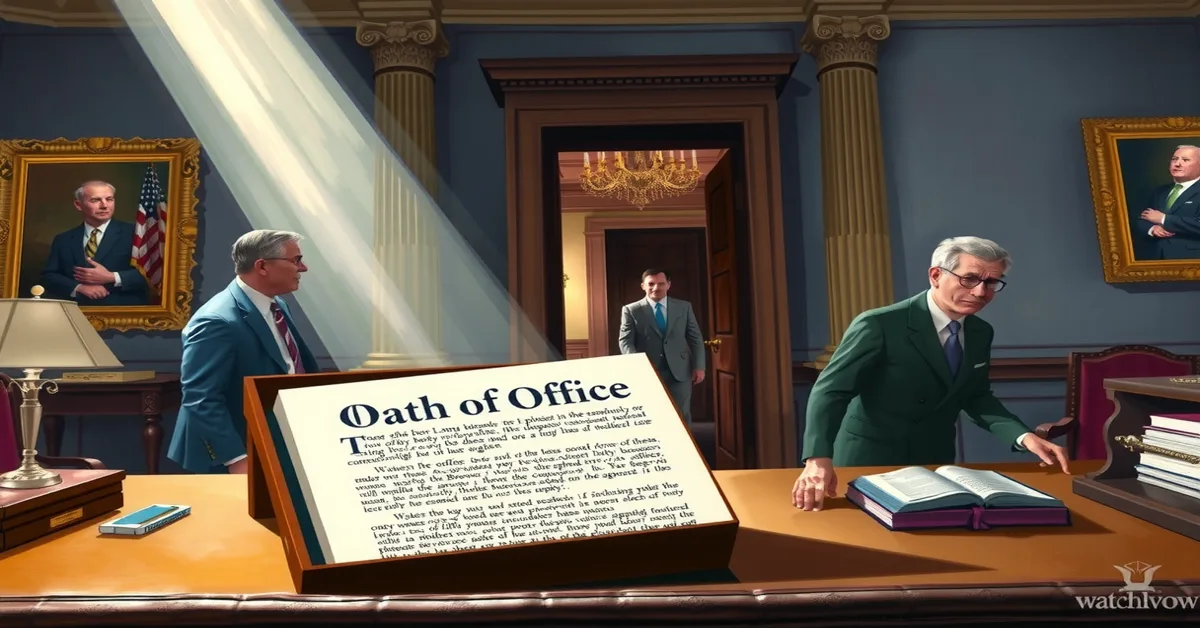
Congress has steadily transferred lawmaking to administrative bodies, and as a result unelected rulemakers now shape everyday life through thousands of binding decisions each year. He, she, or they see complex technical standards set by agencies under vague statutes, while courts often defer to agency interpretations via Chevron and similar doctrines, leaving the Founders’ Article I role hollow. Who truly governs when Congress passes blanks for agencies to fill?
The Rise of Bureaucratic Power
Beginning in the early 20th century and exploding after New Deal statutes, Congress created agencies to handle technical tasks; by design they hold rulemaking, enforcement, and adjudication powers. They expanded further in the 1970s with environmental and consumer protections and again after the 2008 financial crisis, so he, she, or they now confront concentrated administrative authority that was once the exclusive province of legislators.
Key Agencies and Their Influence on Policy
Agencies like the EPA, FDA, SEC, and CDC issue standards that affect markets, health, and private conduct; for example, EPA air and water rules have driven multi-billion-dollar compliance programs, while FDA approvals determine which medical products enter the market. He, she, or they rarely encounter these specifics in statutes—the details emerge from agency rulemaking instead of congressional text.
Consider Dodd-Frank (2010), which empowered the CFPB, SEC, and other agencies to draft dozens of implementing regulations after the 2008 collapse; agencies produced highly technical rules through notice-and-comment rather than line-by-line congressional debate. He, she, or they often find regulatory architecture created administratively, not legislatively, shaping sectors for years before Congress revisits the underlying statutes.
The Lack of Public Oversight and Accountability
Congressional hearings and GAO audits exist, but real-time oversight is weak: agencies finalize rules through internal processes, and he, she, or they typically face enforcement prior to any effective legislative check. Courts’ deference and the sheer volume—thousands of final rules appear annually in the Federal Register—mean public scrutiny is overwhelmed and accountability diluted.
Undoing or constraining agency action demands costly litigation, executive orders, or new laws—each slow and uncertain; rolling back major environmental or financial rules has taken administrations years and multiple court battles. He, she, or they must rely on legal challenges or political shifts while entrenched agency staff, insulated by tenure and technical expertise, continue shaping policy with limited direct electoral control.
The Supreme Court and the Non-Delegation Doctrine
The Court now decides whether Congress may quietly shift lawmaking to agencies or must reclaim Article I duties; since J.W. Hampton (1928) endorsed the “intelligible principle”, deference prevailed, but recent shifts challenge that baseline. He, she, or they who feel rules from agencies instead of statutes should ask: who answers for policy choices made by unelected officials? West Virginia v. EPA and Gundy thrust the doctrine back into contested territory.
Historical Overview of the Non-Delegation Doctrine
Early cases like J.W. Hampton (1928) created the intelligible principle test; two 1935 decisions (Panama Refining and Schechter Poultry) rejected broad delegations, but thereafter the Court rarely invalidated statutes. He, she, or they watching this timeline see a pattern: nearly a century of tolerated delegation where Congress gives agencies discretion to set binding standards without detailed statutory commands.
Recent Supreme Court Cases Affecting Delegation
Gundy v. United States (2019) split the Court over SORNA’s delegation to the Attorney General, while 2022’s West Virginia v. EPA deployed the major questions doctrine to limit EPA power; the Court also blocked OSHA’s vaccine-or-test rule, signaling heightened skepticism. He, she, or they observing these rulings face a Court increasingly willing to curb expansive agency reach.
Gundy involved a statute letting the Attorney General decide SORNA’s registration timing; the fractured 2019 opinions left doctrinal uncertainty but opened the door to renewed challenges. West Virginia v. EPA (6–3) invalidated EPA reliance on broad statutory language to remake energy policy, showing the Court will demand clear congressional authorization for high-impact rules. He, she, or they affected by regulatory upheaval now see litigation as a decisive policy tool.
Implications of a Strengthened Non-Delegation Doctrine
If the Court enforces a tougher non-delegation rule, Congress would have to write far more detailed statutes, shifting political accountability back to legislators while slowing rulemaking. He, she, or they who depend on predictable regulation—business owners, patients, investors—could face both greater clarity and shorter-term uncertainty as agencies lose broad discretion.
Strengthening non-delegation would force explicit congressional choices on issues from emissions limits to drug approvals, likely triggering a surge in legislative bargaining and interest‑group pressure. At the same time, it could prompt a wave of litigation as parties test where the new line falls; he, she, or they living under agency rules should expect both restored Article I authority and near-term policy turbulence.
Major Questions Doctrine: A New Approach to Delegation Oversight
Will the Court finally force Congress to decide the big issues itself? The Major Questions Doctrine tells judges to demand clear congressional authorization before agencies claim sweeping authority, a shift felt in high-profile rulings from 2000 to 2022. He notes how this changes litigation strategy, she watches administrative rules get narrowed, and they see agencies retreat from the boldest assertions of power; the result is a legal tool that can either restore Article I primacy or gridlock policy unless lawmakers act.
Introduction to the Major Questions Doctrine
How far may an agency reach without an explicit statute? Courts now require a distinct signal from Congress when rules have vast economic or political significance, rejecting broad delegations based on vague language. He sees this as a check on agency overreach, she sees pressure on Congress to legislate with greater precision, and they confront a new standard that elevates textual clarity over deference in rulemaking. Clear text, not inference, governs the biggest policy moves.
Cases that Highlight the Doctrine’s Effectiveness
Which precedents prove the doctrine works? Key examples include FDA v. Brown & Williamson (2000), where the Court denied FDA authority to regulate tobacco absent explicit statutory text, and West Virginia v. EPA (2022), where the Court constrained EPA’s use of generation-shifting to meet emissions targets. He points to those years as hinge points, she cites their impact on agency strategy, and they use these decisions to argue that courts will police major delegations more aggressively. Statutory silence is no longer a green light.
Brown & Williamson emphasized historical congressional action and statutory context to reject agency expansion, while West Virginia cut back on the EPA’s interpretation of the Clean Air Act to impose systemwide power-plant changes; together they show judges weighing policy significance, legislative history, and practical impact. He notes the 100+ employer threshold in the OSHA vaccine-or-test fight illustrated limits on public-health mandates, she tracks how agencies now craft narrower rules, and they anticipate more litigation testing these boundaries.
Future Implications for Congressional Delegation
What happens next to delegation practice? Expect Congress to face hard choices: draft explicit authorizations for major programs or accept that courts will strike down broad agency actions. He warns of slower policymaking if lawmakers must legislate details, she sees an opportunity to reclaim Article I duties, and they understand that the doctrine incentivizes clearer statutes or regulatory restraint. Either Congress legislates clearly, or agencies will see their largest moves curtailed.
Practically, this will reshape areas like climate policy, health emergencies, and financial regulation: agencies may avoid omnibus approaches and adopt incremental rules, while stakeholders file more suits demanding textual proof of authority. He predicts tougher statutory drafting from committees, she expects agencies to seek explicit congressional mandates, and they both foresee a resurgence of legislative responsibility if the Court keeps enforcing the doctrine. Less inference, more text — or less agency power.
National Emergencies and the Expansion of Executive Power
When crises hit, Congress often hands broad authority to the executive, and that transfer can become permanent: since the 1976 National Emergencies Act, presidents have declared dozens of emergencies enabling wide statutory powers; after 9/11 they used the AUMF to justify long-term military action, and during COVID-19 the Defense Production Act and public-health proclamations reshaped daily life. How far will they let those temporary tools stretch before Article I is hollowed out?
The Context of Delegation During Crises
During emergencies Congress routinely enacts or invokes sweeping grants like the Stafford Act, the Defense Production Act, and the AUMF so agencies can move fast; for example, the DPA compelled manufacturers to prioritize ventilators and PPE in 2020, and Stafford declarations released billions in disaster aid. Given this pattern, he or she who needs speed often gets latitude, and they watch statutory gaps become permanent authority.
Legislative Abdication and Executive Overreach
Too often Congress declines detailed statutes, leaving agencies to fill blanks with regulations or the President to redirect funds; in 2019 a presidential border emergency attempted reallocation of military construction funds without new appropriation, prompting litigation and questions about separation of powers. If Congress refuses to legislate, who enforces the constitutional boundary between lawmaking and execution?
Courts and litigants have repeatedly tested those limits: the 2019 border-wall dispute produced multiple suits and stays, while post-9/11 uses of the AUMF licensed targeted strikes across regions for years. They expose a pattern—Congress authorizes broadly, agencies and the executive act vigorously, and the judiciary is left to police vagueness; the result is an expanding administrative reach built on ambiguities Congress never corrected.
Balancing Security and Constitutional Principles
Security demands real powers, yet the Constitution vests lawmaking in Congress, so the tension is structural; recent jurisprudence—most notably the rise of the major questions doctrine and cases like West Virginia v. EPA—signals the Court may limit agency grabs when issues are economically or politically significant. Can they preserve urgent flexibility without surrendering Article I’s gatekeeping role?
Practical fixes exist: Congress can insert sunset clauses, reporting requirements, and narrow statutory standards, and use tools like the War Powers Resolution or explicit appropriations to constrain executive drift. If they legislate precise triggers and timelines, he, she, and they restore accountability while allowing necessary rapid responses; absent that, crises become the pretext for permanent power shifts.
The Challenge of Accountability: Who Holds Power?
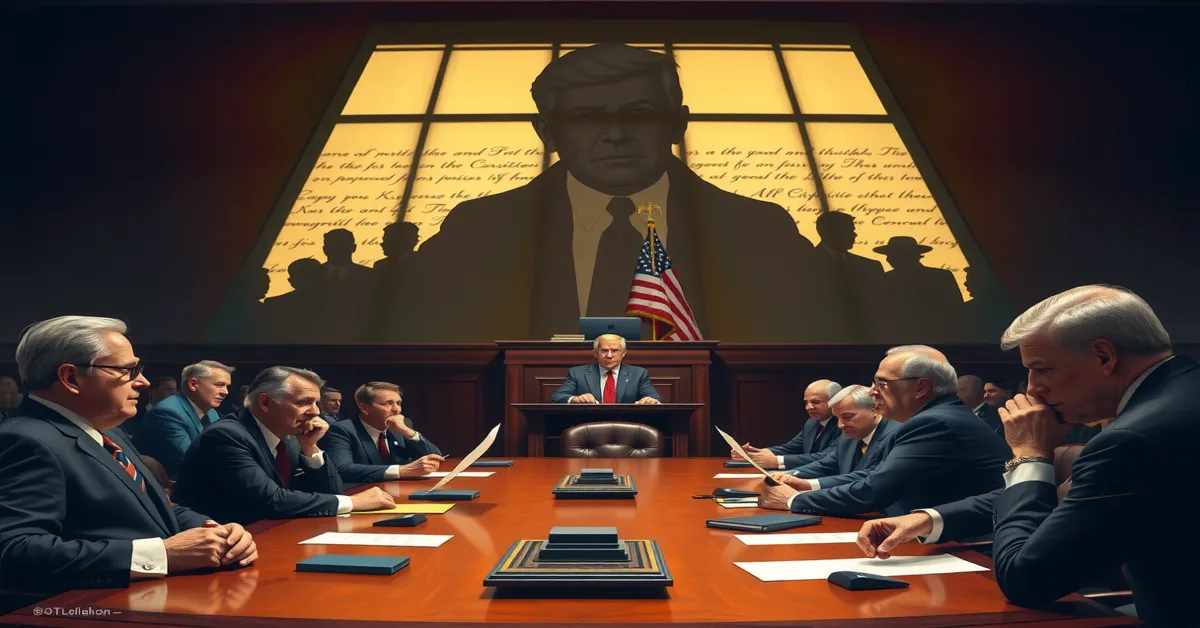
When statutes are vague, he, she, and they cannot trace authority, creating an accountability gap: Congress delegates, agencies act, and oversight frays. The Supreme Court’s renewed attention to the major questions doctrine in cases like West Virginia v. EPA and the post‑Gundy debate show judges may rein in delegated power. Meanwhile agencies publish thousands of rules and guidance documents annually, so who answers when regulations reshape daily life?
Mechanisms for Accountability in Delegated Governance
Congress exercises oversight through committees, appropriations riders, and subpoenas; the courts police procedures via the Administrative Procedure Act and judicial review; inspectors general and Government Accountability Office audits probe agency conduct. Yet he, she, and they confront limits: Congress holds dozens of hearings but seldom repeals complex rules, and judicial doctrines have often deferred to agency expertise, blunting these safeguards.
The Role of Citizens in Oversight
Civic actors use public comment, FOIA, and litigation to contest agency action: he, she, and they file comments during typical 30–60 day notice-and-comment periods, request internal records to expose deliberations, and join suits that can vacate or remand rules—tactics frequently deployed by environmental groups, businesses, and state attorneys general.
When major rules draw concentrated attention, outcomes change: mass comment campaigns have forced agencies to revise or withdraw proposals, and coordinated lawsuits—such as state-led challenges that produced the West Virginia v. EPA decision—can strip agencies of contested authority. He, she, and they increasingly rely on state attorneys general, public-interest litigators, and coalitions to identify APA defects, assemble administrative records, and secure injunctions that restore legislative responsibility.
The Pitfalls of Lack of Checks and Balances
Without firm checks, power centralizes: regulatory capture lets industry shape rules, emergency authorities expand without full congressional debate, and agencies issue penalties or licensing rules that function as law. He, she, and they face enforcement and sanctions crafted by unelected officials, undermining the separation of powers the Framers intended.
Consider recent crises: public-health responses empowered agencies to act swiftly, and financial regulators and enforcement bodies have imposed billions of dollars in penalties, often via administrative adjudication. Historically, doctrines like Chevron gave agencies interpretive room; when vague statutes meet broad delegated authority, policy shifts from Congress to bureaucracies, leaving he, she, and they with few practical remedies to reclaim legislative primacy.
The Limits of Delegation: Unlawful Transfers of Power
When delegation becomes abdication, courts must confront whether Congress has effected an unlawful transfer of Article I power; he, she, and they see the issue most clearly where statutes leave core policy choices to agencies without meaningful standards, turning lawmaking into administrative fiat and eroding the constitutional text that vests lawmaking in Congress alone.
Criteria for Lawful Delegation
What counts as lawful? The Supreme Court has long required an “intelligible principle”—dating to J.W. Hampton (1928)—and practical tests: Congress must supply goals, limits, and standards so agencies do not make foundational policy choices; Panama Refining and Schechter (both 1935) illustrate that absence of such guidance can render a delegation unconstitutional.
Examples of Unlawful Delegation in Practice
Which delegations crossed the line? In 1935 the Court struck down the NRA and hot‑oil controls in Schechter and Panama Refining; modern disputes surfaced in Gundy v. United States (2019) over sex‑offender rules and in challenges to sweeping agency rulemaking that effectively creates criminal liability or major economic policy without congressional direction.
On the ground, unlawful transfer often looks like statutes that let agencies set criminal definitions, massive fines, or industry‑wide limits with no legislative standard; he, she, and they confront agencies issuing thousands of binding rules and assessing civil penalties that reshape markets and personal liberty absent clear congressional policymaking.
Legal Consequences and Remedies Available
What remedies exist when delegation is unlawful? Courts may grant injunctions, vacate agency rules, issue declaratory relief, or strike statutes as void; Congress can also amend or repeal ambiguous grants, and affected parties may sue, though plaintiffs often face standing and deference hurdles in federal court.
Practically speaking, the Court rarely struck down delegations after the 1930s, but recent doctrines—most notably the major questions approach used in West Virginia v. EPA (2022) and the fractured opinions in Gundy—signal growing judicial willingness to limit agency reach, while he, she, and they seeking relief must still prove concrete harm and statutory vagueness to prevail.
The Public’s Role: Advocating for Constitutional Fidelity
Who will hold power to account if he, she, and they remain passive while unelected bodies write the rules? Citizens can pressure representatives, support litigation, and amplify oversight to reclaim Article I authority. By mobilizing through town halls, targeted campaigns, and strategic litigation, the public can turn passive acceptance into active oversight and force Congress to choose between legislating or owning the consequences of delegation. Unchecked delegation becomes harder when voters demand clear statutes and accountability.
The Importance of Civic Engagement
When he, she, and they submit comments under the Administrative Procedure Act, attend oversight hearings, or vote with delegation practices in mind, agencies face real political feedback. Public engagement has reshaped EPA and FDA rulemaking in past rulemakings, and sustained constituent pressure prompts representatives to introduce clarifying statutes or hold hearings. Participation in rulemaking and sustained constituent contact turn abstract constitutional questions into tangible political costs for lawmakers who dodge Article I duties.
Strategies for Reclaiming Legislative Authority
He, she, and they can press for specific tools: use the Congressional Review Act to disapprove rules, back non-delegation statutes that require clear standards, push for sunset clauses and reauthorization cycles, and fund targeted oversight investigations. Litigation—challenging agency actions on standing or overreach—also works in tandem with public campaigns. Combining oversight, legislation, and legal challenges forces Congress to either legislate clearly or bear accountability for agency decisions.
More detail: strategic campaigns pair legal suits (challenging Chevron deference or the scope of agency power) with political tactics—petitions, coordinated messages to key committee chairs, and electoral pressure on members of pivotal committees. He, she, and they may support bills requiring precise statutory delegations, or back appropriations riders that limit agency rulemaking. Case law shifts, like the post-Gundy debate over the major questions doctrine, show how litigation plus public pressure can change judicial treatment of delegation.
The Potential for Reforming Delegation Practices
Reform opportunities exist if he, she, and they demand clearer statutes and procedural limits: require Congress to set specific standards, mandate periodic reauthorization of major regulatory programs, and repeal blanket delegations. Legislative fixes—plus court willingness to enforce an intelligible-principle standard more strictly—would restore Article I’s role. Statutory clarity and reauthorization cycles offer a practical roadmap to constrain agency discretion and return lawmaking to elected lawmakers.
More detail: practical reforms include drafting statutes with measurable criteria, imposing automatic sunsets requiring affirmative re-authorization every 3–10 years, and expanding reporting and transparency obligations so committees can monitor agency rulemaking. He, she, and they can back model bills that limit agency rulemaking to narrowly defined grants of authority and pursue judicial clarification of standards like the intelligible principle or major questions doctrine to prevent future open-ended delegations.
Reassessing the Balance: Delegation vs. Democratic Principles
When weighing delegation against the Framers’ design, the tension is stark: since J.W. Hampton Jr. Co. (1928) and the Administrative Procedure Act (1946), Congress routinely left gaps for agencies to fill, and recent rulings like Gundy (2019) and West Virginia v. EPA (2022) show the Court wrestling with limits. Should he, she, or they accept rulemaking by unelected officials when the intelligible principle has become a near-blank check? Examples—EPA emissions standards and FDA emergency authorizations—show lawmaking often occurs outside elected halls.
Evaluating the Philosophical Implications of Delegation
Philosophically, delegation forces a trade-off: Article I concentrated lawmaking in Congress to ensure accountability, yet practical governance pushed technical choices to agencies. Does he, she, or they tolerate that penalties, criminal definitions, and sweeping standards are set by officials outside electoral control? Founders’ warnings in Federalist essays about separation of powers gain urgency when representation and blame migrate from legislators to agency rulebooks.
The Relationship Between Delegation and Governance
In practice, delegation reshapes governance: the Clean Air Act empowered the EPA to set technical emissions targets, while the SEC writes rules affecting financial markets worth trillions. When he, she, or they examine outcomes, agencies set compliance timelines, levy fines, and define exceptions—functions indistinguishable from lawmaking—so policy often advances through rulemaking rather than statute.
More concretely, the Clean Power Plan (2015) shows delegation’s reach: Congress provided statutory goals, the EPA translated them into binding targets, and the Supreme Court later limited agency latitude in West Virginia v. EPA (2022). Likewise, Gundy tested delegation under the Sex Offender Registration Act and produced a fragmented Court, leaving the intelligible-principle test unsettled; litigation, not legislation, now often redraws governance boundaries.
Future Perspectives on Democracy and Delegated Governance
Looking ahead, shifts in jurisprudence and legislative tools could restore balance: the major-questions doctrine and cases like West Virginia v. EPA signal judicial limits, while the Congressional Review Act (1996) and REINS Act proposals try to force Congress to own major policy choices. Will he, she, or they accept rulemaking by judges and bureaucrats, or reclaim authority so that elected representatives explicitly set the terms?
Deeper reforms would combine judicial restraint with legislative action: a revived nondelegation standard requiring precise statutory directives, expanded use of the Congressional Review Act (which permits expedited disapproval within 60 legislative days), mandatory sunset clauses for agency rules, and stronger Office of Information and Regulatory Affairs cost-benefit review. Political resistance is real—REINS failed repeatedly—so a coordinated mix of judicial doctrine and targeted statutes offers the most plausible path to return significant policy choices to Congress.
The Reawakening of Legislative Responsibility: A Call to Action
Will he, she, they tolerate Congress abdicating lawmaking any longer? Recent litigation — from Gundy v. United States (2019) to West Virginia v. EPA (2022) — shows the judiciary is willing to curb agency overreach, and that legal momentum can force Congress to act. Concrete tools exist: targeted statutory drafting, appropriations riders, and the Congressional Review Act, which in 2017 overturned more than a dozen agency rules, proving that political will can regain legislative authority.
Movement Towards Revitalizing Congressional Authority — Who will force the legislature to legislate?
He, she, and they can point to specific practices Congress can adopt now: require express standards in every delegation, attach sunset clauses to expansive grants of authority, and insist on line-item rule approval for any regulation with over $100 million economic impact. Oversight hearings and GAO audits already exposed opaque rulemaking; when lawmakers use these tools consistently, delegation becomes less palatable and accountability increases.
Mobilizing Public Support for Constitutional Accountability — Can citizens make Congress legislate again?
He, she, and they should pressure representatives through town halls, targeted petitions, and scorecards tracking votes on delegation. Multi-state litigation and coordinated state AG actions have previously forced agencies to retreat; at the same time, public campaigns helped prompt Congress to invoke the Congressional Review Act in 2017, showing organized civic pressure translates into concrete rollbacks of agency rules.
More info: Grassroots pressure paired with institutional levers works: in 2015–2017, coalitions of state attorneys general and industry groups mounted coordinated suits and comment campaigns that stalled major rules, while more than a dozen regulations were repealed via CRA in early 2017 after concentrated outreach and legislative lobbying. He, she, and they can replicate that playbook—combine litigation funding, targeted media, and constituent-level electoral pressure—to make delegation politically costly and restore statutory clarity.
Future Steps for Reinforcing Legislative Power — What practical reforms will restore Article I?
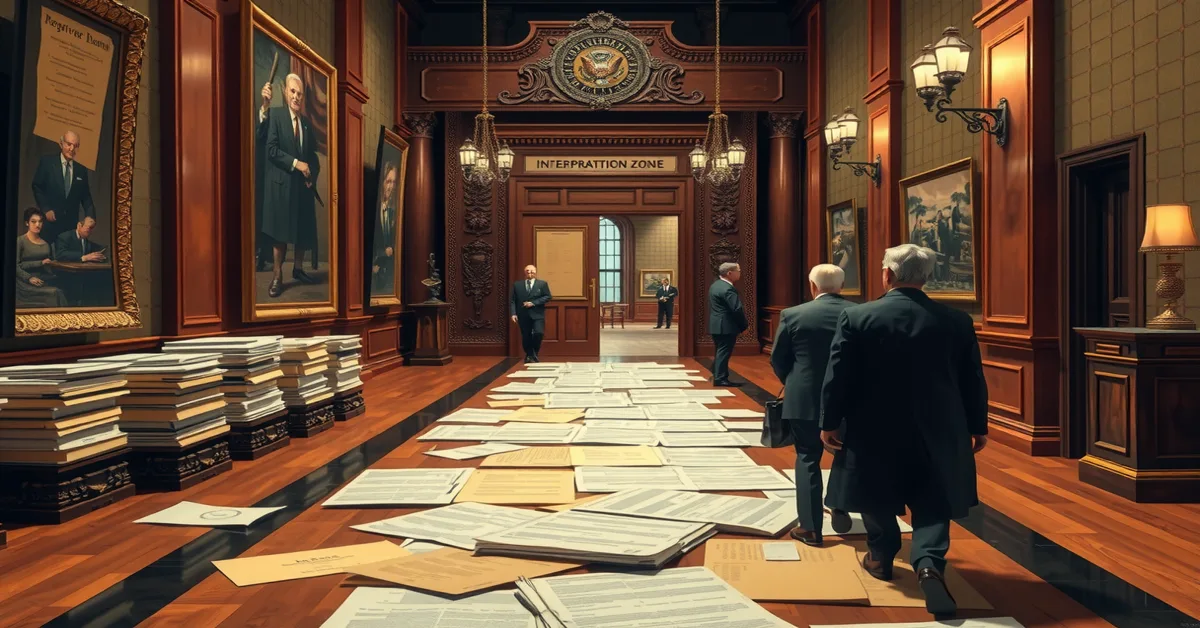
He, she, and they should back reforms like mandatory congressional review for rules exceeding $100 million impact, statutory intelligible principle tightening, five-year sunset reviews, and transparency mandates requiring cost-benefit and statutory-authorization memos. Strengthening appropriations oversight and using targeted riders can immediately constrain agencies while longer-term APA amendments can rebalance lawmaking back to Congress.
More info: A concrete legislative package could include (1) a “Legislative Responsibility Act” obligating Congress to affirm rules with major economic or liberty impacts within 180 days; (2) a statutory threshold—aligned with OMB standards—forcing express authorization for actions over $100 million; and (3) mandatory five-year sunsets on broad delegations paired with GAO review reports. States already use sunset commissions and legislative review to trim agency power, offering replicable models; if he, she, and they mobilize behind these precise reforms, Congress can reclaim Article I duties.
Final Words
Ultimately, he, she, and they see that when Congress delegates its lawmaking, unelected officials shape daily life—who then protects their liberties? This evasive transfer weakens constitutional separation, shifts accountability, and demands that citizens, courts, and lawmakers insist Congress reclaim its proper role before representation becomes an illusion.
FAQ
Q: Are unelected bureaucrats quietly writing the rules that govern your daily life?
A: Yes. Over decades Congress has delegated broad authority to agencies and executive offices, allowing unelected officials to issue binding regulations that affect businesses, healthcare, property rights, and personal choices. Those rules can carry fines, criminal penalties, and compliance mandates even though they were not crafted through the Article I lawmaking process by elected legislators.
Q: How did Congress build this loophole and why does it feel like a bait-and-switch?
A: The loophole grew from Congress outsourcing complex policymaking to agencies for efficiency and political cover. Courts adopted the “intelligible principle” test, which permits delegation if Congress provides a loose standard. In practice this lets legislators dodge hard votes, claim plausible deniability, and shift blame while agencies fill in the details with sweeping regulatory power.
Q: What exactly is the “intelligible principle” and why does it let Congress evade responsibility?
A: The “intelligible principle” is a judicial standard that requires only a basic guideline from Congress when delegating authority. Because the guidance can be vague—terms like “reasonable,” “necessary,” or “in the public interest”—agencies obtain wide discretion to define scope and enforcement. That vagueness turns lawmaking by elected representatives into rulemaking by career officials who lack direct accountability to voters.
Q: Isn’t delegation sometimes necessary for technical or emergency rules—how do we protect the Constitution without hampering governance?
A: Delegation for narrow, clearly defined technical tasks can be legitimate, but the problem is open-ended grants of power that let agencies decide major policy questions. Constitutional protection means insisting on specific statutory standards, sunset clauses, mandatory congressional findings, and procedures that force lawmakers to take responsibility for major choices rather than hiding behind agencies.
Q: How has the Supreme Court handled the non-delegation issue, and is there reason for hope?
A: Since the 1930s the Court largely tolerated broad delegations, but recent decisions and doctrines—like the major questions approach and cases such as Gundy—have reopened the debate. Some justices now signal greater willingness to police extreme transfers of power, suggesting that courts may start enforcing limits where agency authority resolves matters of vast political and economic significance.
Q: What are the real-world costs when Congress keeps passing the buck to regulators?
A: Costs include weakened accountability, unpredictable compliance burdens on small businesses, concentration of power in the executive branch, erosion of separation of powers, and rules that can reshape society without direct legislative mandate. When vital policy gets decided by regulation instead of statute, the people’s representatives shirk their duty and citizens lose clear recourse at the ballot box.
Q: What practical steps can restore legislative responsibility and protect constitutional lawmaking?
A: Require Congress to legislate clear standards and limits, use plain-language statutes with defined delegations, add express nondelegation clauses or reinvigorate the doctrine in law and litigation, demand congressional oversight and rollbacks of vague rules, and elect representatives who pledge to reclaim Article I authority. Judicial enforcement combined with smart legislative reform can curtail the loophole and return meaningful lawmaking to elected lawmakers.















